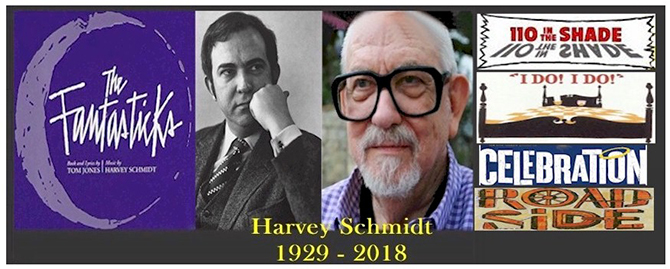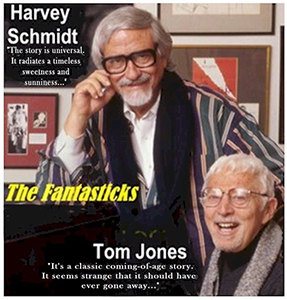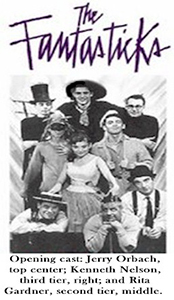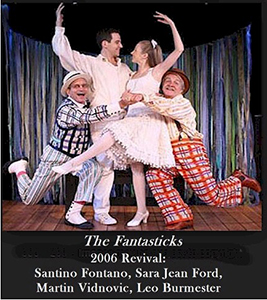Remembering Harvey Schmidt:
Composer of The Fantasticks

By Ellis Nassour
Harvey Schmidt-of the composing team Tom Jones and Harvey Schmidt died Wednesday at his longtime home in Tomball, TX. He was 88. The duo created the longest-running musical in history, The Fantasticks, which ran 42 years Off Broadway and was revived Off Broadway in July 2006 – June 2017; the Broadway musicals 110 in the Shade, I Do, I Do, and Celebration, and Off Broadway’s Road Side.
Jones and Schmidt were inducted into the American Theatre Hall of Fame in 1998. The composers have stars in the Lortel Theatre Off-Broadway Walk of Fame.
A memorial in New York is being planned.
Remembering Harvey Schmidt – and Tom Jones, who recently turned 90:

The Fantasticks, the world's longest-running musical, is a show that all but the most hardened soul love. The story is schmaltzy - the ageless one about boy and girl fall in love/boy and girl fall out of love/boy and girl fall back in love. For over six decades Tom Jones and Harvey Schmidt's musical enthralled millions across the U.S. and in over 80 countries. It is also one of the world's most-honored musicals, with awards upon awards including, on home turf, the Obie and, in a rare recognition of an Off Broadway show, a 1992 Special Tony Award. In its initial Off Broadway run, "the little musical that endured," as it came to be called, racked up a record-shattering 17,162 performances [May 1960 - January, 2002]. Songs "Soon It's Gonna Rain," "They Were You," "I Can See It," and especially "Try to Remember" have become theater and pop standards now known to generations. All these years later, as Jones once put it: “They still have the magical ability to soar.”
Their cleverly-rhyming opening number sung by Jerry Orbach in The Fantasticks, “Try to Remember,” has been recorded by hundreds, including by Ed Ames, Harry Belafonte, Perry Como, Placido Domingo, Eddie Fisher, Kingston Trio, Gladys Knight, Liza Minnelli, Roy Orbinson, Patti Page, and Barbra Streisand, and, among many others, Andy Williams. Ironically, considering the legend that's grown up around the show, it almost didn't happen.
Flashback to August, 1959:
Tom Jones, Harvey Schmidt and Charles Word Baker [1923 – 1995; who went on to become a Broadway stage manager, do some “doctoring” on 1982’s cult hit Pump Boys and Dinettes, and a veteran stage/TV director] met as students at the University of Texas, where Jones and Schmidt were at work on a "unique new entertainment" for its time.
A professor introduced Jones to Edmond Rostand's 1890 play Les Romaneques, a story of two fathers - next door neighbors - who concoct a feud to fool their romance-obsessed son and daughter into falling in love.
"It had a profound effect on me," he says, "but I didn't think of it as a source of a musical. In fact, I'd never seen a musical, except in the movies. We did hundreds of plays in college, but not one musical. It was later, in graduate school, when I met Harvey and Word, that I began to discover musical theater."
On their move to New York, while writing special material for revues, the duo decided to write a "fun musical." "I don't remember who suggested the Rostand piece," says Jones, "but we all agreed. Then Harvey and I got drafted."
When they returned to civilian life, the duo continued working on their show, which championed such new ideas as an open stage. After another three years, they were about to throw in the towel when Baker suggested trying it out in summer stock.

The Fantasticks, as they titled it, a one-act blithe spirit of a musical about love in all its gorgeous simplicity and heartbreaking complexities, would be on a triple bill in New York in Barnard College's summer festival. Taking the plot a bit further, Jones added the fathers arranging a fake abduction of the girl, Luisa, so that the boy, Matt, can gallop heroically to her rescue. “Regarding the title, Jones notes, “The fathers refer to Luisa and Matt as being ‘fantastic.’ I added the ‘k' to make it sound more mysterious."
Its early inception was written in verse. At Bernard, they operated “on a less-than-shoestring budget. Schmidt, an accomplished illustrator, designed and executed the costumes in bare bones fashion. “Still they had color and sparkle,” he boasted. The "orchestra" was Schmidt playing piano. In a stroke of later genius, he added a harpist to accompany the songs [for most later productions, that was the instrumentation].
It was Jones' job to get producers uptown to see the show. Rehearsals ran smoothly until the dress. Susan Watson, playing Luisa, was recovering from a fall from the ladder that was the show's only scenery – except for the strolling players’ trunk, and strained her vocal chords. She could hardly manage a whisper. The choreographer stepped in to Watson's dances, and Schmidt sang her songs. It was some performance.
"We didn't know what else could go wrong," exclaims Jones.
In one of those rare show business stories that change lives forever, a fledging producer, Lore Noto, accepted the invite. “Afterward,” said Schmidt, “he told us that he thought the show would be perfect for the booming world of off-beat Off-Broadway.”
"Like all producers," recalled Schmidt, "he had some suggestions. They were minor. One was that the show be expanded to two acts. We couldn't help but love Lore when he told us that he'd produce the show only if we had total creative control."
Jones and Schmidt were so broke, they held auditions in their Upper West Side apartment. "We couldn't afford a casting director," remembers Jones. "Hopefuls were lined up out the door and down four flights of stairs. I don't remember how Jerry [Orbach] heard about the show, but he came and sang and read. He was sensational."
Then and there, the composers and Baker decided he'd be the perfect El Gallo and they went to tell him; but Orbach, late for another audition, had left to grab the subway. Related Schmidt, "We ran down the stairs, past the other waiting actors and caught him at the corner." As fate would have it, Orbach scored at the next audition and was offered a role in a new Broadway show. "At five times the salary Lore could pay!" said Schmidt.
But, later stating he just had “this gut feeling about the musical,” Orbach chose The Fantasticks. The show he was up for closed out of town.
The other members of the original cast were: Thomas Bruce, actually, Jones, as Henry and George Curley as Mortimer – the “strolling players”; Rita Gardner [the short-lived 1963 Pal Joey revival, and a noted Broadway stand-by; later, The Wedding Singer] as Luisa; William Larsen as Hucklebee [the girl's father]; Kenneth Nelson [later of Boys in the Band fame] as Matt; Richard Stauffer as the Mute; and Hugh Thomas as Bellomy. Jay Hampton had the role of the Handyman, which was eventually dispensed with.

The performance space at the 150-seat Sullivan Street Playhouse in Greenwich was only a little larger than a throw rug. The bare-bones set consisted of a piano at center, multi-colored streamers, a wooden “wall,” a bench, the strolling players’ trunk, and a cardboard moon hung on a pole. From inception, Jones and Schmidt thought their creation would be the perfect show for what was shaping up to be a unique decade. Maybe they were a bit ahead of their time.
“Way ahead of our time,” laughed Jones. “Our opening was punctuated not only by the snores of sleeping audience members, but also by such comments as “I don't understand it!' and ‘What the hell was that?' And then came the reviews!"
They weren't money notices," exclaimed Schmidt.
Jones says they weren't that bad. For the most part, they were. So much so, that he spent the better part of the wee hours with an escape to Central Park, drinking heavily and throwing up.
Then, as now, hopes were high for an excellent notice from the all- important Times reviewer; then the much-respected Brooks Atkinson, known to love innovative theater. He wrote: "Two acts are one too many to sustain the delightful tone of the first. [It's] the sort of thing that loses magic the longer it endures."
The days after the opening were rocky. The Fantasticks appeared doomed.
However, even critics puzzled by the musical praised the cast and Baker's staging.
“We were up and running,” tendered Schmidt, “but it was far from ‘Hurrah.’ We couldn’t even fill 150 seats. We bled for nine weeks. It was a miracle Lore didn’t close the show." Claims Jones, "It was amazing that we had a second night, much less that we were able to run that first week with hardly any audience. What had we done wrong? What had we done right? Of the handful of people involved, no two of us remember it quite the same. That goes for Harvey and I, and we were there; and have been answering questions about it for over fifty years." Even at then-Off Broadway prices of $2.95, $3.95 and $4.95, Gardner says, "audiences were sparse. Sometimes we played to ten and twenty people. It got so bad that Lore suspended performances and took the show to East Hampton. We generated enough word of mouth there to assure some kind of life back on Sullivan Street."
Thanks to excellent outer critics' reviews and word-of-mouth from the hipsters who loved the show and, most importantly, the gradual exposure songs from the show received on TV, The Fantasticks went on to have quite a life. Indeed, by its third year it was an established hit, with avid fans returning again and again. It remained a must-see for years, was declared “a sleeper success” by Time, and proved very popular during the height of the Asian tourist invasion.
Noto's 50 original investors received a 35% return on their $16,500 total investment. One investor only put in cash because he was guilt-ridden for sleeping through the dress rehearsal. A profitable snooze.
Schmidt was later to say part of the show’s success was due to "the story being universal. It radiates a timeless sweetness and sunniness."
As a result of his fantastic reviews, Orbach was Broadway-bound in 1961 as the lead in David Merrick's production of bob Merrill and Michael Stewart’s Carnival, directed and choreographed by Gower Champion.
In 1986, The Fantasticks almost closed when Noto became ill. "When the closing notice was placed in the Times," reported Schmidt, "there were protests. Calls and letters poured in from around the world. We were saved when Lore's friend Don Thompson stepped in to take over until he recovered. Within a week, performances were sold out.”
In addition to setting a world record in New York, The Fantasticks gave performances at the White House. According to Jones, the show was been seen by ten presidents. It also established record runs in Los Angeles, San Francisco, Denver, and many other cities. It played London and was translated into over 20 languages.
Four years after closing, Jones directed the 2006 revival [and often stepped into the cast, again, as Henry]. It starred Santino Fontana, Sara Jean Ford, and, as El Gallo, Burke Moses. “Except for a bit of political correctness to address some controversy over the usage of the word ‘rape,’” states Jones, “not much attempt was made to change the show. It was pretty much as it was when running Off Broadway for 42 years. The songs still had the magical ability to soar.”





